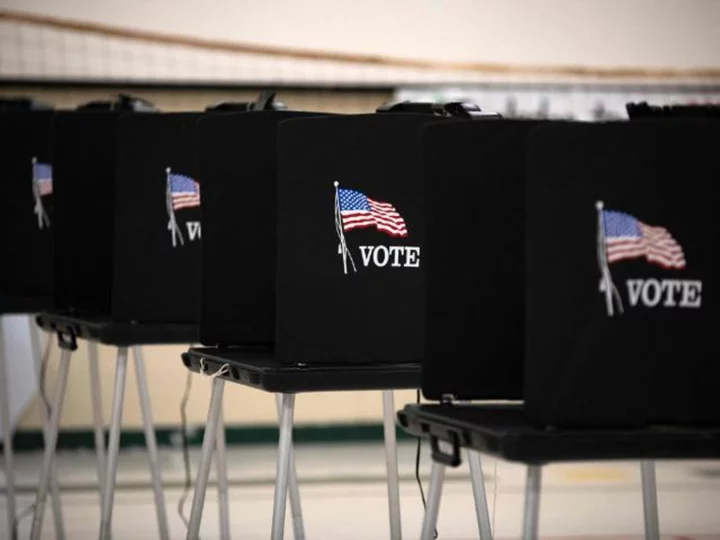Only 37% of eligible American citizens voted in all three of the most recent national general elections, according to a report released Wednesday by the Pew Research Center -- even though those elections saw some of the highest turnout in decades. The analysis, which tracked individual Americans' voting decisions over the past six years, highlights both the limited share of the public that consistently votes, and the degree to which the fluctuations in turnout can alter the electoral landscape. The findings, taken in conjunction with other, sometimes-conflicting sources of election data, help to draw a more detailed profile of the 2022 electorate.
About a third of eligible citizens participated less consistently, voting in only one or two of the last three elections, the report found, while 30% didn't vote in any of those contests.
Consistent voters in the past three elections were about evenly divided between those aligned with the Democratic Party (49%) and those aligned with the GOP (50%). The partisan mix of less-consistent voters, by contrast, varied between each election.
There was also significant demographic variation in which groups most reliably turned out, with older and White Americans more likely to vote consistently.
And regardless of what drives any individual's decision -- or ability -- to vote in a given election, that volatility in turnout can have a big impact on electoral outcomes. The Pew report suggests that changing turnout played a far bigger role than changing minds in the past two midterms.
"Voters who were more favorable to Republican candidates turned out at higher rates compared with those who typically support Democrats," the report's authors write. "Shifting preferences among individual voters -- though likely consequential in some races -- was a much smaller factor in the 2022 midterms compared with turnout."
Among voters who participated in the last two midterms, 95% who backed a GOP House candidate in 2018 went on to do the same in 2022, while 92% of 2018 Democratic voters remained Democratic in 2022. Even such a minor shift in voting preference can be meaningful in tight elections -- and the report notes that some groups, including rural voters and White voters with no college degree, were disproportionately likely to switch sides.
But the bigger difference had to do with who didn't cast a ballot last year. People who voted in 2018, but not in 2022, favored Democrats in the 2018 election by a roughly 2-to-1 margin, 64% to 33%, the report finds. By contrast, 2022 voters who hadn't participated four years prior leaned toward the GOP.
That characterization includes closely watched subgroups such as Hispanic voters, a bloc which the report estimates favored Democratic candidates by a 21-point margin in last year's election, down from a much broader 47-point margin in 2018. According to Pew, Republicans' relatively strong performance with Hispanic voters in 2022 was also "driven by asymmetric changes in voter turnout among Hispanic adults, rather than changing preferences among individual Hispanic voters."
As we noted when reviewing similar data in the wake of the 2020 election, none of these findings are intended to convey a sense of pinpoint accuracy. As the report notes, "Measuring turnout among different groups in the electorate is challenging; it is particularly difficult to assess changes in turnout from election to election."
But because the Pew study is based on surveys conducted largely in the wake of the past four national elections, all conducted using the same online panel, it's able to mitigate that difficulty by tracking specific individuals' voting patterns over time. Researchers also validated that participants actually voted by matching them against several commercial voter files that aggregate official state turnout records; 95% of voting eligible respondents included in Pew's analysis of 2022 voting patterns were matched to voter file records.
Even so, different sources of election data still disagree substantively on some, though not all, aspects of the electorate. The Pew data, for instance, largely aligns with both national exit polls and another voter-file based report published this spring by the Democratic firm Catalist when it comes to what percentage of the 2022 electorate belonged to various racial groups, or held a college degree. But while Pew finds that female voters last year favored Democrats over Republican by just a 3-point margin, both Catalist and the exit polls put that margin at a broader 8 or 9 points, a difference that might lend itself to wholly disparate interpretations about the trajectory of women voters over the past four years.
Election analysis also differs depending on what the authors are using as their primary comparison points. Because the Pew report focuses on comparing 2022 to the 2018 midterms -- when Democrats won in a wave election amid an unpopular Republican presidency -- its conclusions mainly highlight the ways in which Democrats lost traction in the most recent election.
Catalist's report, by contrast, looks at how the 2022 election "defied conventional wisdom" that suggested Democrats would have typically fared worse in a year when they held both the White House and Congress, arguing that last year's midterms stood out from the past in part because of unusually regionalized results.
"Recent midterms have typically involved national waves that favor one party over the other, particularly when there's backlash against a party that controls the presidency and both chambers of Congress," the Catalist authors wrote. "But in 2022, there was no national wave in either direction. Instead, Republicans enjoyed an overall advantage nationally, but Democrats outperformed them in highly contested races, where Democratic turnout and support levels were higher."
The Pew Research Center surveyed 11,377 US adults in November 2022, using the nationally representative American Trends Panel, including 7,041 adult citizens who were ages 18 or older in 2018 and for whom reliable data on turnout and vote choice are available for the past four general elections. It previously surveyed 11,818 adults in November 2020 and 10,640 adults in November 2018. More details on the survey methodology are available here.









